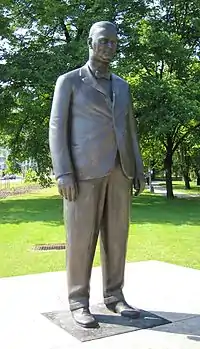Jan Antonín Baťa
Jan Antonín Baťa (March 7, 1898 – August 23, 1965) (also known as Jan Antonin Bata or Jan Bata, called The King of Shoes) was a Czech shoe manufacturer from Uherské Hradiště (southeastern Moravia), half-brother of Tomáš Baťa.
Jan Antonín Baťa | |
|---|---|
 Statue of Jan Antonín Baťa across the street from the Baťa’s Skyscraper built in 1938 in Zlín. | |
| Born | 7 March 1898 |
| Died | 23 August 1965 (aged 67) |
| Nationality | Czech |
Together with American experts, he participated in the First Prague International Management Congress (PIMCO) in July 1924 in Prague, organized by the Masaryk Academy of Labour.[1]
After the death of his half-brother in 1932, who had founded the firm, Jan Antonin Baťa headed the Baťa company. In 1931 he converted it to a joint stock company, Baťa a.s., still based in Zlín, former Czechoslovakia.
Bata's administration began in May 1931. He implemented new growth plans for the Baťa businesses at the height of the Great Depression. His efforts included expansion into new industries, including: shoe production machinery, tires, textiles, chemicals, mines, canals, a railway, film studios, manufacture of airplanes and bicycles, development of retail department stores, import/export.
At the time when Bat'a became owner and chief executive officer, the Baťa organization employed 16,560 co-workers that maintained 1,645 shops and 25 enterprises. Most of it was located in Czech lands (15,770 employees, 1,500 shops, 25 enterprises) and Slovakia (2 enterprises, 250 employees). The international businesses of the Baťa company consisted of 790 employees, 132 shops, and 20 international enterprises.
During his period, the Moravian and Czech part of the business more than doubled its size to 38,000 co-workers, 2,200 shops, and 70 enterprises. The Slovak enterprises also expanded exponentially in Slovakia from 250 people to 12,340 and 8 enterprises.
In 1939 when Czechoslovakia was annexed by Nazi Germany, Bat'a unsuccessfully tried to negotiate with the German authorities in order to prevent the control of his company from being taken over by the German army. With his family he went into exile to the United States. In 1941 he was blacklisted for having entered into negotiations with the Nazis and was exiled again, settling finally in Brazil. There he founded several company industrial towns, including: Bataiporã, Bataguassu, Batatuba, Anaurilândia and Mariápolis, communities where more than 100,000 people live today.[2]
Up to his death, Bat'a expanded the organization more than sixfold from the date of purchase. From 1931 to 1942, the Bata organization grew to 105,770 employees.
The Baťavilles were new cities, new industrial communities, each with a specialized purpose, based on the "ideal city" model. In 1935 Jan Bat'a proposed a contest for ideal city designs. "In 1935, [Jan] Bata invited Le Corbusier to Zlin as a member of the jury of Bata's International Housing Competition and for consultations over the factory city plans." The way Bata introduced the Ideal city concept was based on an architectural design competition.
Czech Republic
- Zlin (Tomas and Jan Bata)
- Otrokovice – Batov (1930−1934),
- Trebíc, Czech (1933),
- Moravia - Slovakia Bata Canal 60 Kilometers (1935)
- Zruc nad Sázavou (1938),
- Sezimovo Ústí (1939)
Slovakia
- Bošany (1931−1934)
- Svit (1938)
- Nové Zámy (1935)
- Liptovský sv. Mikuláš, (1938)
- Baťovany (today Partizánske, 1938)
Europe
- Best, The Netherlands, (1933−1934)
- East Tilbury, England, (1933−1934)
- Hellocourt, France, (1933−1935)
- Vernon, France (1935)
- Neuvic, Dordogne, France (1939)
- Brussels, Belgium (1937)
- Borovo, Croatia (1931−1935)
- Möhlin, Switzerland (1933)
- Chelmek, Poland (1932)
- Martfü, Hungary (1941)
Outside Europe
- Batanagar (India 1934−1935)
- Belcamp, Maryland USA, (1936−1939)
- Batawa, Canada (1937−1939)
Brazil
- Batatuba (1939)
- Mariapolis, Brazil (1941)
- Bataguassu (1953)
- Município de Batayporã (1963)
- Município de Anaurilândia (1963)
Other Bata factories
- Syria (1934)
- Iraq, Baghdad (1934)
- Klang, Malaya (1935)
- Mansurieh (suburb of Alexandria), Egypt (1936)
- Gwelo formerly Rhodesia, later Gweru, Zimbabwe, (1937)
- Indonesia (1938),
- Peru, Lima (1939)
- Chile, Batafler (1939)
- Java Island, Batavia Kalibata (1939)
- Kenya, Nairobi/Limuru (1939)
- India, Lahore (1939)
- Morocco, Casablanca (1939)
- Belgian Congo (1940)
- Bolivia, Quillacollo (1940)
- Senegal, Dakar French West Africa (1940)
- Guatemala (1940)
- Haiti, Port-au-Prince (1940)
- Vietnam, Haiphong (1940)
- Philippines (1940)
References
- PRECLÍK, Vratislav: K stému výročí vzniku Masarykovy akademie práce (One hundred years of the foundation Masaryk´s Academy of Labour), in Strojař (Machinist): časopis Masarykovy akademie práce (The Journal of the Masaryk Academy of Labour in Prague), leden – červen (January to June) 2020, roč. (Vol.) XXIX. , dvojčíslo (two No.) 1, 2./2020, ISSN 1213-0591, registrace Ministerstva kultury ČR (registr. of Ministry of Culture Czech Republic) E13559, pages 2–20
- Witzel, Morgen (2003). Fifty Key Figures in Management. Psychology Press. p. 25. ISBN 9780415369770.
External links
- Batahistory.com at the Wayback Machine (archived October 16, 2007)
- Official website
- Newspaper clippings about Jan Antonín Baťa in the 20th Century Press Archives of the ZBW